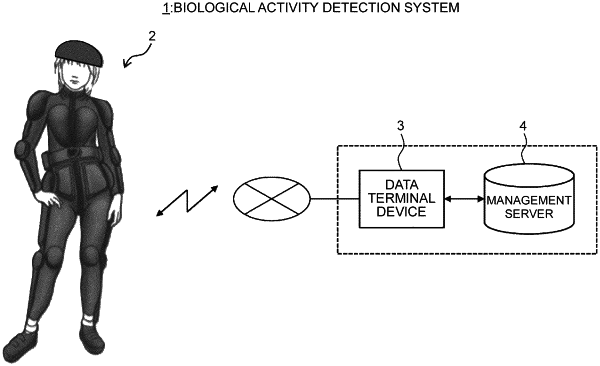| CPC A61H 1/0262 (2013.01) [A61B 5/291 (2021.01); A61B 5/296 (2021.01); A61B 5/344 (2021.01); A61B 5/389 (2021.01); A61B 10/00 (2013.01); A61F 2/72 (2013.01); A61H 3/00 (2013.01); B25J 9/0006 (2013.01); B25J 11/00 (2013.01); B25J 13/08 (2013.01); B25J 19/02 (2013.01); A61B 2505/09 (2013.01); A61H 2003/007 (2013.01); A61H 2201/1626 (2013.01); A61H 2201/1642 (2013.01); A61H 2201/1652 (2013.01); A61H 2201/5007 (2013.01); A61H 2201/5061 (2013.01); A61H 2230/085 (2013.01); A61H 2230/105 (2013.01)] | 16 Claims |

|
1. A biological activity detection apparatus comprising:
a periarticular detection unit that detects a periarticular physical quantity around a joint in association with a limb motion of a subject on a basis of an output signal from a drive unit that actively drives or is passively driven in conjunction with the limb motion of the subject;
a biological signal detection unit that is located at a body surface site of the subject with reference to the joint and includes an electrode group for detecting a biological signal of the subject;
a biological signal processing unit that acquires a myogenic potential signal associated with muscle activities of the subject and a neural transmission signal to cause a motion of a musculoskeletal system of the subject from the biological signal acquired by the biological signal detection unit;
a brain activity measurement unit that is mounted on a head of the subject and measures a brain wave and a cerebral blood flow in a measured area of the head; and
a status quantification unit that converts an activity status of the musculoskeletal system and/or a transmission status of a peripheral nervous system around the joint into quantitative musculoskeletal system data and/or nervous system data and converts a transmission status of a central nervous system around the head based on measurement data of the brain wave and the cerebral blood flow, which are acquired from the brain activity measurement unit, into quantitative nervous system data on the basis of either one or both of the physical quantity acquired from the periarticular detection unit and the myogenic potential signal and the neural transmission signal which are acquired from the biological signal processing unit;
a gravity center position detecting unit that detects a gravity center position of the subject; and
a walking state recognition unit that recognizes a walking state of the subject on the basis of the driving state of the drive unit and the gravity center position detected by the gravity center position detecting unit,
wherein the status quantification unit also reflects a recognition result of the subject's walking state, which is acquired from the walking state recognition unit, in the musculoskeletal system data and/or the nervous system data;
a stimulus imparting unit that is located corresponding to the electrode group of the biological signal detection unit and includes terminal groups to impart physical stimuli to a body surface of the subject;
a stimulus control unit that controls each of the terminal groups of the stimulus imparting unit,
wherein the stimulus control unit adjusts at least one or more of a strength level, a pattern, and a time of the stimuli imparted by the stimulus imparting unit until any change in a signal waveform of the biological signal detected by the biological signal detection unit appears, and
wherein the status quantification unit also reflects a stimuli-imparted result by the stimulus imparting unit in either one or both of the musculoskeletal system data and the nervous system data; and
a processor that generates a three-dimensional body map image that represents the activity status of the musculoskeletal system, the transmission status of the central nervous system, and the peripheral nervous system on the basis of either one or both of the musculoskeletal system data and the nervous system data,
wherein the processor detects appearance acquisition information representing a body reaction of the subject,
wherein the status quantification unit reflects the appearance acquisition information, which is acquired from the processor, in the musculoskeletal system data and the nervous system data, and
wherein the appearance acquisition information include eye motions of the subject, pupillary reflexes, a distribution of body temperatures, body motion reactions to a visual sense state, and an auditory sense state, facial expressions, and a degree of leg lifting.
|